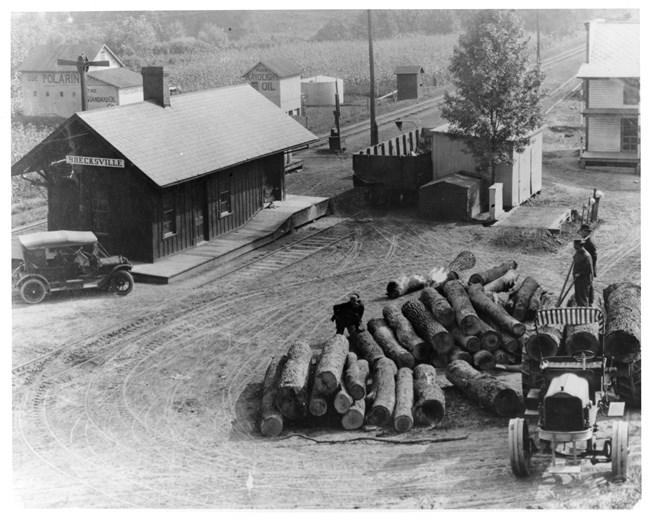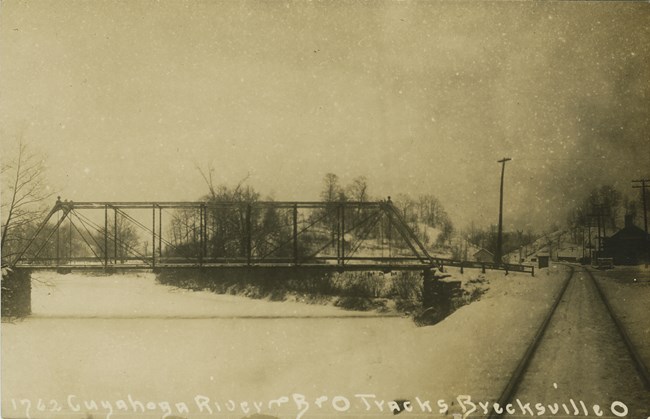Last updated: December 21, 2022
Article
Preserving the Station Road Bridge

© J.J. Prekop, Jr.

NPS Collection
The Pinery Narrows is a logical place for a bridge across the northern Cuyahoga Valley. As the name implies, it is the skinniest part. When Valley Railway began its service in 1880, Brecksville Station and its access road opened just south of this pinch point. Both were on the west bank of the Cuyahoga River, near the Pinery Feeder Dam. According to county records, Station Road Bridge was built soon after the train came through—in 1881, although the bridge bears the date “1882.” (Perhaps they waited for warmer weather to hold an official ceremony?) The bridge linked Station Road in Cuyahoga County to Pine Hill Road in Summit County. Because the train station was an important economic hub, the two counties split the bridge cost of just over $3,600.

Jon Sherba Collection
Wrought Iron and Wood
The manufacturer was the Massillon Bridge Company, a local firm. They likely made the bridge off-site and shipped it in pieces for assembly by local laborers. In technical terms, the style is a Double Intersection Pratt (Whipple) Truss. Covered bridges had been the norm for horse-drawn traffic. Starting in the late 1800s, engineers began using railroad-style bridges to cross spans. Just as railroad traffic moved from wooden beams to iron beams, road bridges moved from wood to iron. Station Road Bridge is made of wrought iron, but is not riveted like a modern bridge. Instead it is pinned like a wooden covered bridge. This bridge “bridges” older and newer styles of construction. Shortly after it was erected, steel became the material of choice.
Because bridges are often replaced over time, this is the only metal truss bridge of its kind left in Cuyahoga Valley. When the arched Brecksville-Northfield bridge was built nearby in 1931, most traffic crossed over on State Route 82. The Station Road Bridge was added to the National Register of Historic Places in 1978, shortly after the national park was established.

NPS Collection
Shipped to New York
During the early years, the national park bought land and assessed the condition of its resources. By 1980 the Station Road Bridge had deteriorated so badly that the two counties closed it. Engineers from the Federal Highways Administration evaluated the bridge the following year and the National Park Service put a plan together to fix it. Funding and land-ownership issues took time to resolve.
A decade after the closure, workers disassembled the bridge in 1991 and shipped it to Elmira, New York for repairs. Decker, Inc. replaced the wooden decking and some metal elements, and repainted the iron structure. The cost was $385,755. The bridge was set back on its piers around August 7, 1992. Dignitaries, including Superintendent John Debo (holding the bow) and Civil Engineer Rob Bobel (with a beard), gathered on August 12 for a re-opening ceremony. Station Road Bridge became pedestrian-only: a vital link between east-west trails in Cleveland Metroparks and a new north-south Ohio & Erie Canal Towpath Trail in the national park. The first 20-miles of the Towpath Trail opened the following year with this as a major trailhead.
Time Again for Major Repairs
The natural elements and human use are hard on bridges. After 30 years, this historic structure needed another makeover. From November 16, 2020 through April 5, 2021, Station Road Bridge once again closed for deck replacement, metal repairs, and repainting. This time it was completely wrapped and the work was done in place. The Federal Highways Administration completed the design, rehabilitation, and inspection with a total project cost of $1,340,000. The new paint is designed to protect the bridge from rust for decades. Temporary fences were necesssary to protect the paint while it cured - a process that took months. Today the restored bridge is once again open to visitor use.
